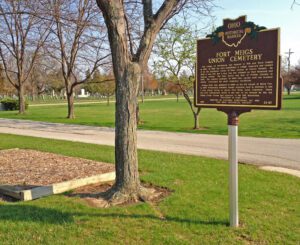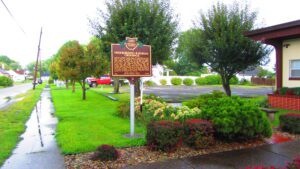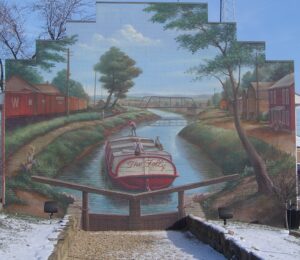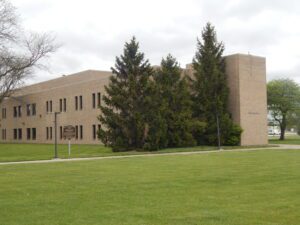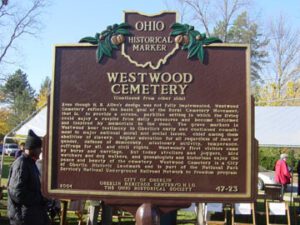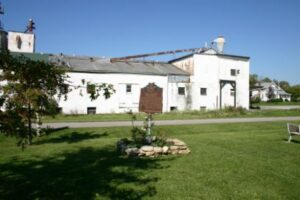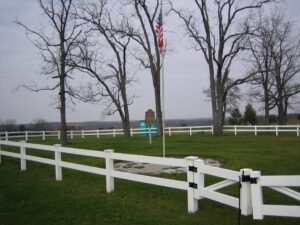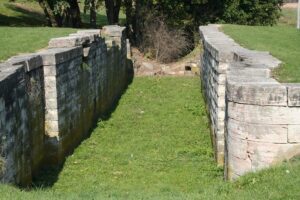, OH
The village of Perrysburg was founded in 1816 and Wood County in 1820. In 1822 the town established a village cemetery and located it on the southwest corner of West Indiana at Cherry Streets. By 1848 it was full and a new one was created on West Boundary and Indiana Avenue. The first burial was that of William Cassady in 1849. The cholera epidemic of 1854 that caused over one hundred deaths, overloaded the small cemetery workforce. Potters Field was designed in 1868 on the NW corner of Block Two. In 1877 Perrysburg Township bought adjacent land in sections K and L and joined forces to create Fort Meigs Union Cemetery. There are nine underground vaults in the side of the terrace by the old Ewing Creek stream bed adjacent to the 1912 mausoleum.
, OH
Underground Railroad crossings, agents, and conductors were common along the Ohio River between Washington County, Ohio and Wood County, Virginia. At Constitution, six miles upriver from Belpre, Judge Ephraim Cutler listened for hoot owl calls that signaled when a boatload of runaway slaves was crossing from Virginia to the Ohio shore. “Aunt Jenny,” a slave woman in Virginia, used a horn signal to alert abolitionist John Stone in Belpre when fugitive slaves were crossing. At Little Hocking, eight miles downriver from Belpre, slaves crossing from Virginia looked for a lantern signal to guide them to the Horace Curtis Station on the Ohio River shore. Runaway slaves were also assisted by Thomas Vickers at Twin Bridges, James Lawton at Barlow, and others as they traveled northward by various routes through Morgan County to Putnam in Muskingum County where the Underground Railroad merged with the Muskingum River Corridor.
, OH
During the 1830s, the Ohio & Erie Canal was built through Newark. The Lockmaster’s House was home to the lockmaster of Lock #9. In 1852, the first railroad locomotive steamed into Newark, signaling the beginning of the end for the canal. By 1871, the Baltimore & Ohio Railroad took over the Lockmaster’s House and the encompassing land, and built the Little Red House on the corner for the stationmaster and telegraph operator. Passenger and freight stations, a freight yard, and roundhouse were constructed nearby and served as a B&O Division Point. In 1881, the Scheidler Machine Works built a factory to manufacture steam engines and sawmills. This building now houses The Works Museum. In 1890, an electric interurban railway line connected Newark’s B&O Station to the Toledo & Ohio Central station in Granville. By 1908, the old canal was filled-in. Interurban service ended in 1929 when the city purchased buses.
, OH
The site of Owens Community College, the Rossford Army Ordnance Depot played a supporting role in the United States’ victory in World War II and in national defense during the Cold War. From 1942 until 1945, the Rossford Ordnance Depot served as a distribution center for military vehicles during World War II. The complex also housed an ammunition storage depot. Virtually a city within itself, it featured an extensive railroad and road grid. Following World War II, the Depot remained a major site for military vehicles but expanded its mission to include tool storage and distribution. On July 1, 1963, General Orders No. 28 deactivated the facility from the United States Army Material Command.
, OH
Shortly after Oberlin Colony was established in 1833, a two-acre burying ground was set aside south of Plum Creek in the area bounded by Main, Morgan, and Professor streets. By 1861, however, with the town and Oberlin College growing and the Civil War escalating, the need for a larger cemetery became clear. After an extensive search, 27.5 acres of land belonging to Henry Safford were acquired one mile west of the center of Oberlin. H.B. Allen was hired to create a design in the style of the Rural Cemetery Movement, and in July 1864 Westwood Cemetery was formally dedicated. Burials in Westwood had actually begun in August 1863, and over the next few years hundreds of remains were reinterred from Oberlin’s “Old Cemetery” and from burying grounds in surrounding communities. In the mid-1860s the cemetery was enlarged to its present 47 acres, and in 2004 burials and memorials were estimated to number almost ten thousand. (Continued on other side)
, OH
On April 19, 1891, a head-on collision between two trains of the Lake Shore and Michigan Southern Railway Company occurred at the Kipton depot. Eight people lost their lives, and the depot was heavily damaged. The crash occurred when a fast mail train heading east near Kipton and a passenger train going west from Elyria collided. The passenger train was supposed to let the mail train go by, but the conductor had not realized that his watch had stopped for four minutes and then restarted. As a result the passenger train was late getting to the stopping point. Looking into the matter, the railway company enlisted Webb C. Ball, a well-known Cleveland jeweler, to investigate time and watch conditions throughout its lines. Ball instituted the current railroad industry’s timekeeping program, which specified watches trainmen could use. His attention to accuracy and promptness led to the well-known saying, “Get on the Ball.”
, OH
A cemetery was established on the site in 1811 and became the final resting place for many of the area’s early pioneer families. The Hanover Township Trustees obtained title to the land in 1823 from John and Anna Farnsworth, and it was expanded for additional plots in 1879. Unfortunately many burials remain unmarked or can be located only by primitive limestone markers above them. The oldest readable headstone is dated 1816. (continued on the other side)
, OH
This section of the Miami and Erie Canal, constructed from 1833-1837, was vital to this region’s commerce and development. It allowed for farmers and businesses to get their goods to larger markets at a lower cost and faster speed than by hauling overland. Passengers could also travel across the area by canal boat. John Clark saw the location of the Lock 15, situated in Monroe Township at the junction of the Milton-Carlisle Pike (Main Street), as an opportunity and in 1840, platted the new town of Tippecanoe City (now Tipp City). Many types of commerce and trade grew up around the canal including boarding houses, saloons, a tannery, and a mill. Some of the original buildings still stand, such as a mill to the west of Lock 15, John Clark’s home at the southeast corner of Main and First streets, and the hotel at the northeast corner of Main and Second streets.


